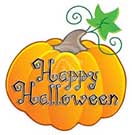|

 |
The Huffington Post
8 Super Weird
Things You Didn't Know About Halloween
By Todd Van Luling & Amanda Scherker
October 24, 2014
This weird Halloween trivia isn't boo-gus.
Halloween is a time for candy, costumes and the Charlie Brown cartoon
special, but how did it become this way? Why are children and teens
encouraged to run around the neighborhood threatening tricks?
Jack-o'-lanterns are a pretty strange concept, but historically,
strangers giving you candy was supposed to be a bad thing.
You may already think that Halloween is a pretty bizarre holiday: What
other celebration could inspire both a Sexy Olaf costume and spooky
drones? That said, sexy snowmen can't hold a candle to Halloween's
truly bizarre origins (even if that's just because a snowman would melt
if it held a candle). Chances are you really have no idea just how
weird Halloween truly is, so here are eight facts to fix that...
1. Originally, you had to dance for your "treat."
Most experts trace trick-or-treating to the European practice of
"mumming," or "guysing," in which costume-wearing participants would go
door-to-door performing choreographed dances, songs and plays in
exchange for treats. According to Elizabeth Pleck's "Celebrating The
Family," the tradition cropped up in America, where it would often take
place on Thanksgiving.
In some early versions of trick-or-treating, men paraded door-to-door,
and boys often followed, begging for coins. Most of these early
trick-or-treaters were poor and actually needed the money, but wealthy
children also joined in the fun. Door-to-door "begging" was mostly
stopped in the 1930s, but re-emerged later in the century to distract
kids from pulling Halloween pranks.
2. Halloween is more Irish than St. Patrick's Day.
Halloween's origins come from a Celtic festival for the dead called
"Samhain." Celts believed the ghosts of the dead roamed Earth on this
holiday, so people would dress in costumes and leave "treats" out on
their front doors to appease the roaming spirits. Granted, the Celts
were not solely based in Ireland when these customs started taking
shape around the first century B.C., but as will be talked about more
in a later section, the Irish Celts were the ones who invented the
jack-o'-lantern. This Halloween prototype was eventually disrupted and
adapted by Christian missionaries into celebrations closer to what we
celebrate today, including partly by the not-Irish St. Patrick, whose
work was later mostly recognized by Americans.
"St. Patrick's Day was basically invented in America by
Irish-Americans," said Philip Freeman, a classics professor at Luther
College in Iowa. According to National Geographic, the holiday was only
a "minor religious holiday" until the 1970s in Ireland. So it's not all
that Irish. And for what it's worth, St. Patrick probably wasn't Irish
himself, his color was a type of blue, not green, and that story about
banishing snakes is actually just a metaphor for his triumph over Irish
paganism. The type of paganism that invented Halloween.
3. If you'd been around for the earliest Halloween celebrations, you
might have worn animal skins and heads.
According to ancient Roman records, tribes located in today's Germany
and France traditionally wore costumes of animal heads and skins to
connect to spirits of the dead. This tradition continued into modern
day celebrations of Samhain, the Celtic holiday that inspired Halloween
in America. On this day, merry-makers often dressed as evil spirits
simply by blackening their faces. The leader of the Samhain parades
wore a white sheet and carried a wooden horse head or a decorated horse
skull (a modern Welsh version of this costume is shown above). Young
people also celebrated by cross-dressing.
For the rest of this article and more, go to Huffington Post
|
|
|
|

